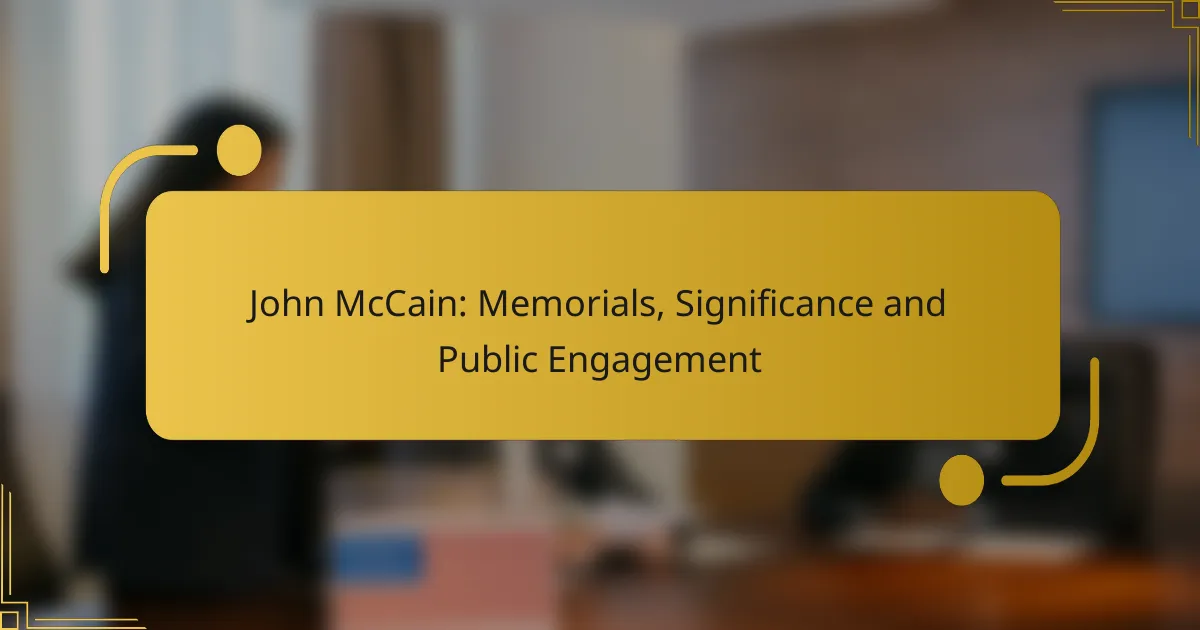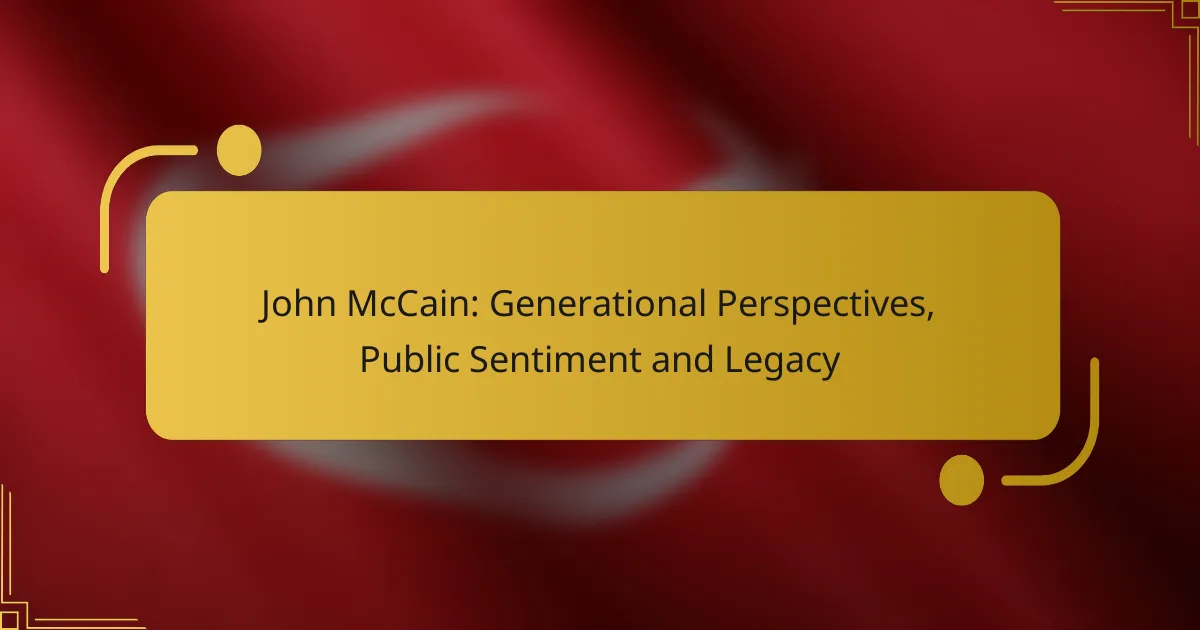John McCain’s adept use of social media transformed his approach to public engagement, enabling direct communication with constituents and fostering a sense of community around his political messages. By strategically leveraging platforms like Twitter and Facebook, he enhanced his connection with voters and shaped political discussions, ultimately leaving a lasting impact on his legacy. His ability to adapt to emerging platforms demonstrated a commitment to accessibility and transparency in an evolving political landscape.
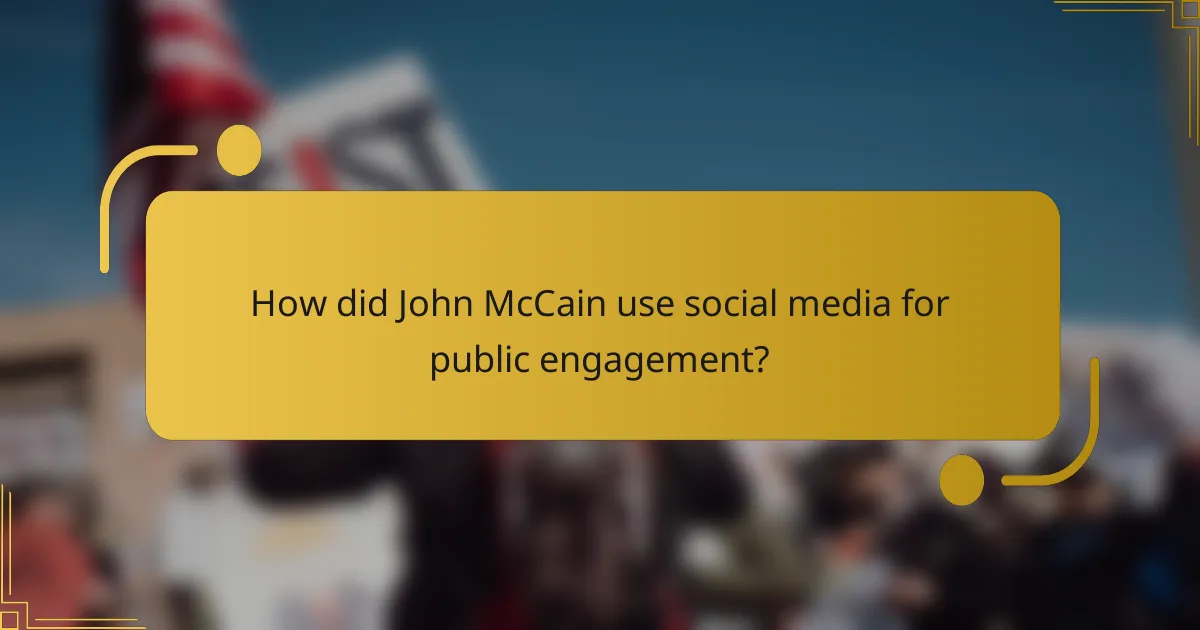
How did John McCain use social media for public engagement?
John McCain effectively utilized social media platforms to enhance public engagement, allowing him to communicate directly with constituents and the broader public. His strategic use of these platforms fostered dialogue and built a sense of community around his political messages.
Utilization of Twitter for real-time communication
John McCain leveraged Twitter for immediate communication, sharing updates, opinions, and responses to current events. This platform enabled him to engage with followers in real-time, often addressing breaking news or responding to constituents’ concerns within minutes.
For example, during significant political events or crises, McCain would tweet his thoughts, providing insights that resonated with his audience. This approach not only kept his followers informed but also encouraged them to participate in discussions, amplifying his reach and influence.
Engagement through Facebook for community building
On Facebook, McCain focused on building a community by sharing longer posts, photos, and videos that highlighted his initiatives and personal stories. This platform allowed for deeper engagement, as followers could comment, share, and interact with his content more extensively than on Twitter.
McCain often used Facebook to host live Q&A sessions, where constituents could ask questions directly, fostering a sense of connection and transparency. This interactive format helped him cultivate a loyal supporter base and encouraged civic participation among his followers.
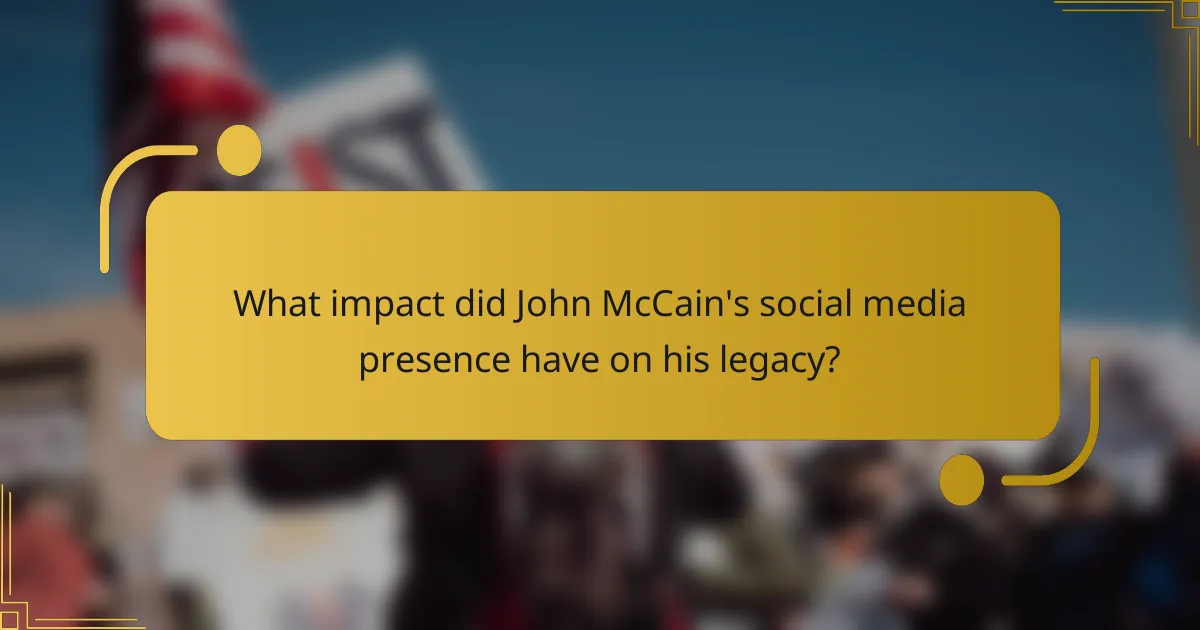
What impact did John McCain’s social media presence have on his legacy?
John McCain’s social media presence significantly shaped his legacy by enhancing his connection with voters and influencing political discussions. His strategic use of platforms like Twitter and Facebook allowed him to engage directly with the public, fostering a sense of accessibility and transparency.
Increased voter outreach and connection
McCain effectively utilized social media to reach a broader audience, particularly younger voters who are more active online. By sharing personal stories, insights, and updates, he created a relatable persona that resonated with many constituents.
His posts often included behind-the-scenes glimpses of his life and candid interactions, which helped humanize him in a political landscape that can often feel distant. This approach not only increased voter engagement but also encouraged discussions around key issues he championed.
Influence on political discourse and engagement
McCain’s social media activity played a pivotal role in shaping political discourse by allowing him to address current events and controversies in real-time. His willingness to engage in debates and respond to critics directly on these platforms set a precedent for future politicians.
Moreover, his use of social media to promote bipartisan cooperation and civility in politics encouraged a more respectful dialogue among followers. This approach helped to elevate discussions beyond partisan lines, fostering a culture of engagement that many politicians continue to strive for today.

How did John McCain’s social media strategy evolve over time?
John McCain’s social media strategy evolved significantly, adapting to emerging platforms and changing political landscapes. Initially focused on traditional platforms, he later embraced newer channels to engage a broader audience and connect with younger voters.
Adoption of new platforms like Instagram
As social media platforms evolved, McCain recognized the importance of reaching audiences where they spent their time. He adopted Instagram to share visual content, which allowed him to connect with younger demographics through engaging images and stories.
This shift not only modernized his campaign approach but also showcased a more personal side, helping to humanize his political persona. By utilizing Instagram’s features, such as Stories and IGTV, McCain was able to provide real-time updates and behind-the-scenes glimpses into his campaign activities.
Shift in messaging during election cycles
Throughout various election cycles, McCain adjusted his messaging to resonate with the prevailing political climate and voter concerns. His social media posts often reflected timely issues, such as healthcare and national security, aligning with the interests of his audience.
For instance, during the 2008 presidential election, he focused on themes of change and bipartisanship, using social media to amplify these messages. In contrast, his later campaigns emphasized unity and experience, showcasing his long-standing commitment to public service through targeted social media outreach.
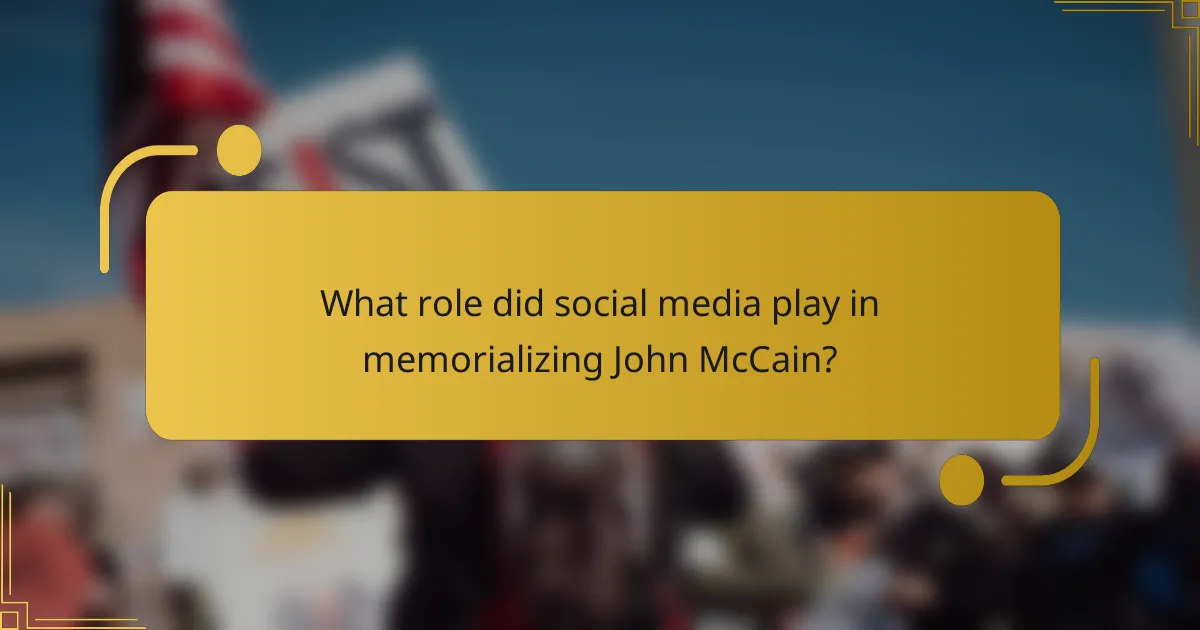
What role did social media play in memorializing John McCain?
Social media significantly influenced the memorialization of John McCain by facilitating widespread tributes and discussions about his legacy. Platforms like Twitter and Facebook allowed individuals, organizations, and public figures to share their memories and reflections, creating a collective remembrance that transcended traditional media.
Tributes and remembrances shared online
Following John McCain’s passing, social media became a hub for tributes and remembrances. Users shared personal stories, photographs, and videos that highlighted his character and contributions, fostering a sense of community among those who admired him. Hashtags such as #RememberingMcCain trended, allowing people to easily find and engage with content related to his life.
Public figures, including politicians and celebrities, also took to social media to express their condolences and share anecdotes about McCain. This not only amplified the reach of these tributes but also encouraged followers to participate in the conversation, further solidifying McCain’s impact on American society.
Public discussions on his contributions
Social media platforms facilitated robust public discussions about John McCain’s contributions to politics and society. Users engaged in conversations about his stances on key issues, such as healthcare, foreign policy, and bipartisanship, often debating his legacy and the lessons to be learned from his career. This dialogue helped to keep his ideals alive in the public consciousness.
Moreover, online forums and comment sections provided spaces for nuanced discussions, where supporters and critics alike could express their views. This engagement not only honored McCain’s memory but also encouraged a broader examination of the political landscape he navigated, prompting users to reflect on the importance of civility and service in public life.
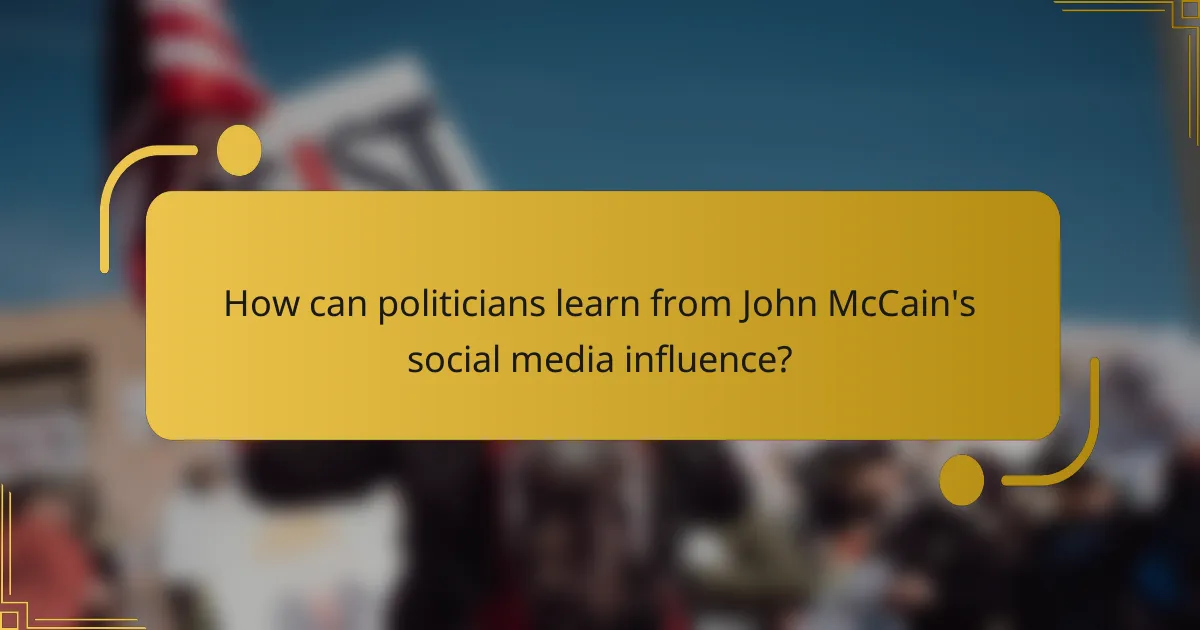
How can politicians learn from John McCain’s social media influence?
Politicians can learn from John McCain’s social media influence by adopting strategies that prioritize authentic engagement and transparency. McCain effectively used social media to connect with constituents, share his values, and respond to public concerns, setting a standard for modern political communication.
Strategies for authentic engagement
To engage authentically, politicians should share personal stories and experiences that resonate with their audience. This approach fosters a sense of connection and relatability, encouraging followers to engage more deeply with their content.
Utilizing interactive content, such as polls or Q&A sessions, can also enhance engagement. By inviting followers to participate in discussions, politicians can demonstrate that they value public input and are responsive to their constituents’ needs.
Importance of transparency and responsiveness
Transparency is crucial for building trust in political communication. Politicians should openly share their decision-making processes and the rationale behind their policies. This openness helps constituents feel informed and involved in governance.
Being responsive to public inquiries and feedback is equally important. Politicians can enhance their reputation by promptly addressing concerns raised on social media, showing that they are attentive and accountable to their constituents.
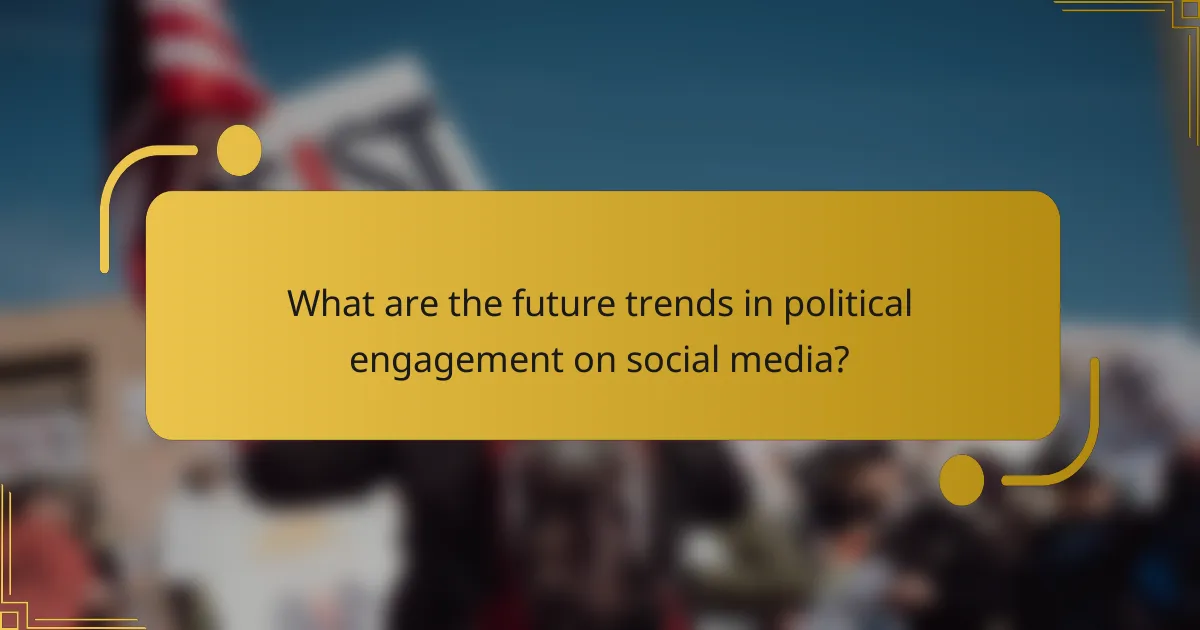
What are the future trends in political engagement on social media?
Future trends in political engagement on social media will likely emphasize more interactive and visual content, alongside the rise of new platforms that cater to diverse audiences. These changes will shape how politicians connect with constituents and influence public opinion.
Increased use of video content
Video content is becoming a dominant form of communication on social media, allowing political figures to convey messages more effectively. Short clips, live streams, and storytelling through video can engage viewers in ways that text alone cannot.
For instance, platforms like TikTok and Instagram Reels are popularizing brief, impactful videos that can quickly capture attention. Politicians can leverage these formats to share campaign updates, policy explanations, or personal stories, making their messages more relatable.
Emergence of new platforms for outreach
New social media platforms are continually emerging, offering fresh avenues for political outreach. These platforms often attract younger demographics, enabling politicians to engage with voters who may not be active on traditional sites like Facebook or Twitter.
For example, platforms such as Discord and Clubhouse provide unique environments for real-time discussions and community building. Politicians can utilize these spaces to host Q&A sessions, fostering direct interaction and feedback from constituents.

